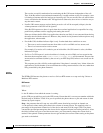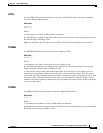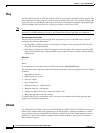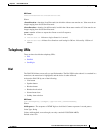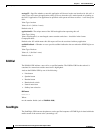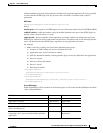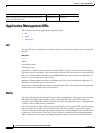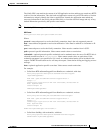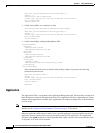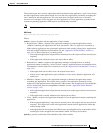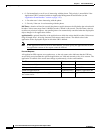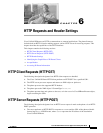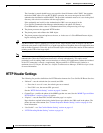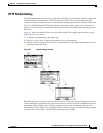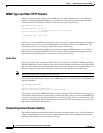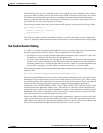
5-18
Cisco Unified IP Phone Services Application Development Notes
OL-20949-01
Chapter 5 Internal URI Features
Application Management URIs
HTTP POST /path/streamhandler?event=stopped HTTP/1.1
Accept: */*
Authorization: Basic 8fh4hf7s7dhf
Content-Type: application/x-www-form-urlencoded; charset=”UTF-8”
Host: myserver:8080
Content-Length: 23
• Called from SoftKey, no credentials, no data
Notify:http:server:8080:path/streamhandler?event=stopped
HTTP POST /path/streamhandler?event=stopped HTTP/1.1
Accept: */*
Content-Type: application/x-www-form-urlencoded; charset=”UTF-8”
Host: myserver:8080
Content-Length: 5
• Called from SoftKey with QueryStringParam URI:
<CiscoIPPhoneMenu>
<MenuItem>
<Name>Voicemail1</Name>
<URL>QueryStringParam:id=1</URL>
</MenuItem>
<MenuItem>
<Name>Voicemail2</Name>
<URL>QueryStringParam:id=2</URL>
</MenuItem>
<SoftKeyItem>
<Name>Play</Name>
<URL>Notify:http:vmailSrvr:8080:path/play</URL>
</SoftKeyItem>
</CiscoIPPhoneMenu>
If the Voicemail2 menu item was selected when the Play softkey was pressed, the following
notification would be sent:
HTTP POST /path/play HTTP/1.1
Accept: */*
Content-Type: application/x-www-form-urlencoded; charset=”UTF-8”
Host: vmailSrvr:8080
Content-Length: 9
DATA=id=2
Application
The Application URI is a component of the Application Management API, which provides an improved
hand-off between call mode and application mode. The Application URI allows applications to request
changes to their application or window state. Applications can request to change focus, to be minimized,
or to be closed.
Note The other component of the Application Management API is the Application Management Event
Handler, see the “Application Event Handlers” section on page 3-22 for details.
When an Application URI request is made, it has a specific application associated with it (not just the
a
pplication context) and that action can only be taken on that specific application. The Application
specified in the appId parameter (of the displayable XML object) must be active at the time the action
is requested, or an error will be returned.



